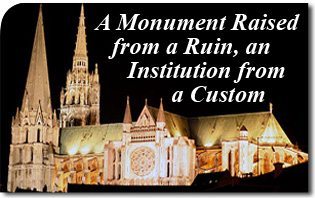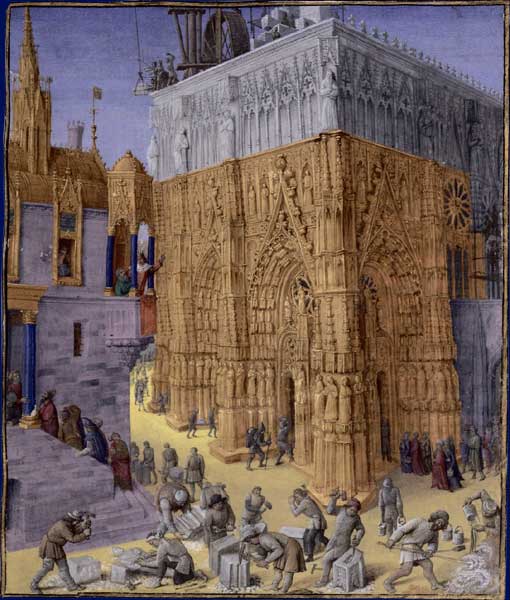 “Consider the diversity of the Middle Ages: on the one hand, there is the razing of cities, the fall of empires, the struggle between races, the confusion of peoples, violence and lamentations; there is corruption, barbarianism; institutions fall and institutions rise, Men disperse and make nations, whole peoples are led to unknown destinations, and yet still, enough light remains to know that everything is out of place and there is no place for anything: Europe is chaos itself.
“Consider the diversity of the Middle Ages: on the one hand, there is the razing of cities, the fall of empires, the struggle between races, the confusion of peoples, violence and lamentations; there is corruption, barbarianism; institutions fall and institutions rise, Men disperse and make nations, whole peoples are led to unknown destinations, and yet still, enough light remains to know that everything is out of place and there is no place for anything: Europe is chaos itself.
“But amidst this chaos, something stands; it is the Immaculate Spouse of Our Lord; and one great success never before seen by mankind prevails: it is a second creation worked by the Church. During the Middle Ages, only one thing seems astounding to me and that is this second creation, and only one thing seems adorable to me and that is the Church. In order to work this great prodigy God chose these obscure times, eternally infamous both for the explosion of all brutal forces and the manifestation of human impotence.
“Nothing exalts the Divine Majesty and Grandeur more than to have worked in this world while no one acted where men, peoples and races struggled in confusion. On two solemn occasions, God willed to show that corruption is sterile and that only virginity is fertile. God Our Lord willed to be born of Mary and He desired to espouse Himself to the Holy Church, thus was the Church the mother of nations just as Mary was His mother.
“Then that Immaculate Virgin, His Church, sharing the solicitude of her Divine Spouse to do good, lifted the spirits of the fallen and moderated the impetus of the violent. Giving to some a taste of the bread of the strong and to others the bread of the meek. Those fierce children of the North, who had humiliated and mocked Roman majesty, fell conquered by love at the feet of this defenseless Virgin, and for many centuries the whole world watched in astonishment and wonder as the Church renewed the prodigy of Daniel who suffered no harm in the lions’ den.
“After having lovingly soothed those great wraths and after having calmed those furious tempests with her gaze alone, the Church raised a monument from a ruin, an institution from a custom, a principle from an event, a law from an experience; to say it in a word, order from chaos, harmony from confusion.
“Undoubtedly, all the instruments used for Her creation, like chaos itself, were taken from that chaos; Hers was only the enlivening and creating force. There was an embryonic form in that chaos, bereft of everything, from which would be born and live the Church who possessed the being and the life. She brought everything into being and everything came alive when the world lent an attentive ear to Her loving words and fixed its gaze on Her resplendent beauty.

“No, men had not seen anything like it because they had not seen the first creation, neither will they see it again, for there will not be three creations. One might say that God, regretting that He had not made man a witness of the first, allowed His Church a second creation just so man could behold it” — Donoso Cortés.
With their elevated topics, forceful thought and distinguished language, the great debates so characteristic of the nineteenth century usually retained something of the nobility of European society before the French Revolution. Thus, they contrast with our century where man conforms to everything provided it has no economic interest and where today’s rare elevated debates are not of interest to a public hypnotized by movies and sports.
Today we bring an echo of those high, fulgent intellectual tournaments to the attention of our readers.
Albert de Broglie, a liberal Catholic, published an article in the Revue des Deux Mondes (11/1/1852) claiming that the enthusiasm for the Middle Ages of certain Catholic writers was excessive. One of the targeted personalities, the celebrated Spanish thinker Donoso Cortés, Marquis of Valdegamas, wrote a reply to de Broglie. Although the author never sent it to the Revue des Deux Mondes, it was later published in his complete works (Obras Completas de D. Juan Donoso Cortés, BAC, Madrid, 2 Vols. 630 pp).
The text printed above is an excerpt from that reply and is a brief and brilliant analysis of the history of the Middle Ages from a theological point of view. It illustrates the elevated tone of the debate and, at the same time, makes a definitive reply to liberals who are disturbed at finding so much enthusiasm for that period of history among Catholics.
With masterly precision, he shows the difference between what was barbaric, weak and chaotic in that period and the order, strength and triumphal progress of Christian civilization. Thus, Donoso Cortés annihilates the accusation, espoused by so many Catholics in his time and today, who admire those centuries of Faith with neither discernment nor restrictions. At the same time, he focuses with admirable clarity on those points that the Middle Ages deserves unrestricted enthusiasm. Primarily, the vivifying and ordering action of the Church and the consequent life and order She gave to institutions, laws and customs.
The Gothic style was born of a society that had been made from the decaying ruins of the Roman world mixed with elements of barbarianism and assailed by furious tempests.
Brought about through the work of the Church, which knew how to raise “a monument from a ruin, an institution from a custom, a principle from an event, a law from an experience; to say it in a word, order from chaos, harmony from confusion,” this admirable style was born from this regenerated decay and barbarianism. This style, more than any other, is able to express the gravity, strength and nobility of the Christian soul.
The preceding article was originally published in Catolicismo, No. 151, July 1963. It has been translated and adapted for publication without the author’s revision. –Ed.
